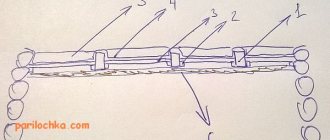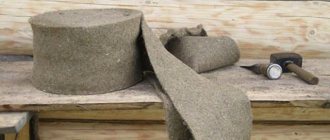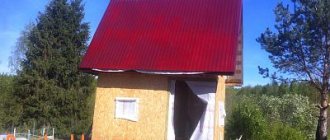The service life of heating sources, boilers, stoves and fireplaces solely depends on the method and material of chimney sealing. This operation is mandatory for every smoke removal system, since even the most high-quality installation of boiler equipment does not guarantee the absence of gas contamination in the premises due to the penetration of flue gases. Leaks in gas ducts can be caused by temperature deformation, leading to ruptures and cracks in the structure. A leaky gas exhaust system is not capable of creating working draft in the boiler unit. As a result, soot accumulates intensely in the pipe itself. This has the potential to become a prerequisite for a fire in the chimney. In order to counter this dangerous phenomenon, you need to know how to seal the chimney.
Purpose of chimney sealing
In order to prevent smoke from leaking through cracks, sealing the chimney is an indispensable condition for its functioning. High-tech heat-resistant seals are used to seal the joint seams of various elements of prefabricated chimneys. In addition, they are used for emergency repair of leaks formed during the operation of heating sources in winter, when it is not possible to disconnect the boiler and replace damaged areas.
Such materials are used to seal cracks in a classic chimney made of brick. Previously, traditionally, clay was used for this, but it is short-lived. In addition, heat-resistant pastes are used to treat the exhaust pipes to the roof - this protects the rafter system from getting wet and rotting.
Areas of application of thermo-sealants and what are the dangers of ignoring cracks in stoves and fireplaces?
Fireplaces and stoves develop cracks in the facing layer during frequent and prolonged use.
This is unsightly from an aesthetic point of view, and is also dangerous to health:
- Fuel consumption increases - additional air from outside enters the combustion chamber, which speeds up the combustion process. You will have to add fuel more often, the consumption will increase 2-3 times.
- Soot and soot - through even the smallest cracks, soot gets out and settles on the ceiling, floors and furniture around the fireplace. You will have to clean several times a day.
- The entry of carbon monoxide into the living room - through cracks, smoke, which should completely exit into the chimney, leaks into the house. This is dangerous due to the development of carbon monoxide poisoning, especially in the absence of proper ventilation.
The most dangerous condition that can develop when the heating system depressurizes is the formation of combustion in the chimney. Due to the high concentration of oxygen and the decrease in combustion temperature in the combustion chamber, highly flammable soot forms on the inner walls of the chimney.
To prevent these negative consequences from overshadowing the operation of the stove or fireplace in the house, heat-resistant sealant is used for minor repairs. This is convenient, since you can cover up a gap or crack yourself at any time, postponing major repairs until the summer.
Heat-resistant sealants are also used for:
- Sealing chimney pipes during installation and repair: sealing small and large cracks along the contour and on the chimney itself.
- Waterproofing of contact points between the roof and chimneys made of various materials.
- Bonding heat-resistant gaskets with metal fittings.
- Seal cracks on the outside of a brick or metal combustion chamber.
Some sealants can be used to restore fire-resistant masonry if there is damage, but there is no way to redo the masonry.
“Craftsmen” claim that there is no point in spending money on sealants, since clay successfully copes with their function. But no kaolin compound can dry out so quickly and seal all sorts of cracks so reliably.
Expert opinion
Borodin Vasily Platonovich
Stove mason, specialist in fireplaces, stoves and heating systems
In practice, sealant is a “lifesaver” if urgent repairs are needed. You will have to tinker with the clay mortar, and the joints between the brick and the metal slab cannot be properly sealed a priori.
How the sealant works
All types of sealants for work in high-temperature zones are divided into 2 fairly large categories - heat-resistant based on silicone materials and heat-resistant with silicate technology. They differ in content and acceptable operating properties. All sealing materials can be divided into several types:
- silicone or silicate technology;
- by content: from one component or two;
- according to temperature indicators: temperature-resistant sealants and heat-resistant.
How the sealant works
All heat-resistant polymers are applied to the defective area between the chimney and the roof, after which they harden or polymerize under the influence of the atmosphere for some time. For home use, one-component kits are used - they harden more slowly, making it easier to correct any errors during application. In industrial production, binary sets are used in which the paste is mixed with a hardener.
Application rules
To ensure that the tightness of the connection does not cause any complaints, it is important to follow some rules when applying sealant:
- The area where the sealant is applied is cleaned of dust and degreased. For silicone products, the application site should be thoroughly dried. For fireproof ones, moisten with water.
- You should work with gloves, avoiding contact of the product with your skin. If this happens, you should rinse the skin with plenty of water.
- For complete hardening of the insulators, you should wait 24 hours with the first firebox.
- It is necessary to conduct a test fire to check the sealing and final fastening of the sealing materials.
- You should start working with any composition only after carefully studying the manufacturer’s recommendations.
Criterias of choice
Before you make a choice about how to seal your chimney, you need to understand that effective means of protection in the smoke ventilation system are not cheap. You should not save your money on heat-resistant sealants. It is safer to purchase these materials from popular brands and in large shopping centers, but it is recommended to keep your receipt. High molecular weight silicone is an expensive material and sometimes there are counterfeits on the Internet.
There is a simple option for checking the material than sealing the gap. If several bottles are purchased, then squeeze out a little of the substance from one, wait until it hardens, and set it on fire. Real silicone is difficult to ignite and burns with the release of a mixture of dark and light soot - hydrocarbons and silicon oxide. Fake sealant, usually containing acrylic and PVC, burns and releases only black soot.
It should also be noted that heat-resistant sealants for furnaces and flues are sold in tubes for a construction gun. If the store recommends polymer in classic tubes, most likely it is all a sealing material for cars; it is acidic in nature and is absolutely not suitable for heating devices and gas ducts. In this regard, carefully study the instructions on the packaging before sealing a stainless steel chimney.
When studying, you need to especially pay attention to the following characteristics:
- Permissible temperature. It must meet the operating conditions in the hot zone.
- Working environment. The sealing material must be neutral.
- Manufacturer's brand. Popular models of heat-resistant sealants are Penosil up to 1300 C, Makroflex up to 260 C, and domestic “Moment Germent”.
- Price. Silicone polymers are much cheaper than silicate ones.
Sealing a pipe on a bitumen roof
Passing a chimney through a Euro slate roof is not an easy task. Its specificity is softness, so it will be quite difficult to use. The best way would be Wakaflex tape. This is an adjacent strip for sealing joints.
It is installed according to the following algorithm:
- The tape cutting is made in advance.
- It is pressed with the help of a case.
- Any gaps are removed using bitumen mastic.
Please note that bitumen roofs are best sealed during the cold season. Under the scorching sun it softens and becomes dangerous. If you move on the roof, there is a possibility of damaging the ondulin.
Types of sealants
One-component sealants are made from a single ingredient and do not require mixing of the elements before performing the sealing procedure. This makes them easy to use and in demand among the owners of individual cottages, who appreciate the quality of such material for insulation work.
Binary or two-component, before work you will need to mix, exactly following the ratios noted in the annotation. At the same time, the prepared product must be completely consumed within a few hours after mixing. This method is not very suitable for sealing seams at home; as a rule, it is used by highly professional builders.
Silicone materials
For convenience and ease, the chemical industry produces a wide range of silicone seals. Such sealants are divided into:
- For acidic ones. When heated and combined with certain elements, acetic acid is released. They should not be used on items that are vulnerable to rust. Due to the above, connections are formed that prevent the optimal operation of the chimney, and its sealing is disrupted.
- Alkaline sealants.
- Heat-resistant silicate-based sealants can withstand fairly high temperatures. They are most used in areas with open flames. They can also be used in leakage areas of heating boilers and installation areas.
At the moment, an adhesive-sealant is presented on the construction markets, capable of being used in very difficult areas, where ordinary material is not tightly fixed. In terms of characteristics, the glue is no worse than similar sealants, and in some ways it is even more advanced. As a result of its use, the strength of the assembly is achieved, a very long-term joint appears, which is practically not affected by external factors.
Heat-resistant products
Heat-resistant sealants are produced on the basis of silicones - organosilicon oxygen-containing syntheses and can withstand ambient temperatures up to 300 C, which exceeds absolutely all conventional elastic seals. They have a long service life, elastic, inert in chemical environments, moisture-proof, very stable to biological influences, solar radiation, capable of functioning under rapid changes in temperature conditions, non-toxic and environmentally friendly.
Heat-resistant silicones are produced in the form of a red-brown paste. The sealant is colored by iron oxides. Design temperatures range from 180 to 310 C, this information is indicated on the packaging.
Silicone use area: sealing the external areas of the chimney, structural joints of the chimney and roof, blind cracks in brick areas, sealing steel pipes, as well as stainless steel structures. A special advantage of heat-resistant sealants is their elasticity. The width of possible compaction is up to 6 mm, the polymerization period is up to 25 minutes. Compaction is performed at positive air temperatures, no more than 45 C.
This sample of sealing materials has a silicone base with the addition of iron oxides. Such additives with a reddish tint not only increase the temperature resistance of the sealant, but also make it inconspicuous when treating brick chimneys. They keep the sealed gap tight for a long time.
Heat-resistant seals
They are used for sealing and repair work on the internal walls of the smoke ventilation system, combustion chambers, brick pipe ducts, wells, joining seams of cast iron and metal parts with the masonry of the heating source, mounting points for sandwich chimneys use fire-resistant silicate polymers operating in a temperature environment of up to 1200 C and short-term – including 1500 C.
Silicate sealing materials are distinguished by black or black-gray color and viscous consistency; they harden within 20 minutes after surface treatment is completed. The seam width is up to 20 mm. Heat-resistant silicates form a low-elastic compound. The ambient temperature during processing operations should be between 1 and 40 C.
The chemical industry has enterprises that produce specific heat-resistant compounds for lining heating devices and chimneys with thermal slabs: fireclay, clinker and porcelain stoneware, as well as facing stone. Typically, they are all produced on the basis of silicates and contain liquid glass, clay, cement, plasticizers and polymer additives.
Such consistencies tolerate temperatures ranging from -25 to +200 C and even more. The industry also uses other high-temperature similar compositions; they seal leaks in large volumes, and drying joints requires powerful heating, so they have not gained popularity in everyday life.
Roof penetrations Master Flash
With the help of such devices, you can quickly and efficiently finish round chimneys. They are much easier to install compared to metal caps. Penetrations are made from silicone and heat-resistant rubber. They allow you to create hermetically sealed structures when the plane is tilted up to 20 degrees. The material can withstand temperatures in the range of 135...240 degrees. The chimney can have a diameter of up to 66 cm.
Roof penetrations Master Flash
Important! You should carefully select the diameter of the penetration, otherwise it may tear (if the size of the chimney exceeds the parameter of the protective element) or not be tightly fixed to the pipe. In the latter case, you will have to use crimp clamps and sealant.
What's good about these products:
- possibility of use on roofs finished with different coatings;
- quick and easy installation;
- resistance to moisture, temperature changes and sunlight;
- budget cost.
Characteristics of the roof passage
Installation technology of elastic penetration.
- A narrow part of the product purchased in accordance with the diameter of the chimney is cut off at a level that allows the device to fit hermetically to the chimney.
- The penetration with the dismantled deflector is pulled onto the pipe until it meets the roof.
- The protection of the self-adhesive base is removed, which is pressed against the corrugated sheet (it must be clean and dry).
- The penetration is fixed using self-tapping screws (roofing). All gaps are filled with sealant.
- Additional protection against leaks and ultraviolet radiation, as well as the aesthetics of the structure, will be provided by a decorative apron, most often made to match the color of the roofing.
Installation steps
As an analogue of Master Flash penetrations, you can use aluminum or steel cone-shaped devices with a silicone connecting part.
When carrying out sealing, you cannot do without sealant. The composition must be resistant to climatic factors and high temperatures.
Prices for Master Flash penetrations
Master Flash penetrations
Rules and principles for sealing chimneys
When working with two types of polymers, it is necessary to prepare the surface of the flue: clean, remove dust and dirt, and degrease. Metal areas must be sanded with fine sandpaper for effective adhesion of the polymer material. The surface under the heat-resistant seal must be absolutely dry. The tube is inserted into the gun and a small amount of material is squeezed onto the edge to be sealed. They provide the opportunity to harden; the polymerization time is usually indicated on the packaging.
The base for the heat-resistant silicate polymer is prepared and slightly moistened. Carefully apply the sealant to seal the gap tightly and allow time to harden. Excess heat-resistant mass is removed before it petrifies. It is possible to pre-glue the length of the seam with masking tape, and then remove it after completion. Activities are recommended to be carried out during the warm period of the year.
Some important rules when using heat-resistant sealants:
- Work with silicate sealing components is carried out in a temperature range from +6 to +41 C.
- The desired connection result is achieved only in the case of rough and uneven surfaces. For this purpose, when used, the areas are pre-treated with grinding materials.
- The surfaces must be degreased with a solvent, after completing the stage, allow them to dry for 20-25 minutes.
- When the mass hardens in the areas where the sealant is applied, very strong and hard seams are obtained; for this reason, it is not recommended to use these heat-resistant kits for systems operating in conditions of high vibration.
- The remaining sealing material is removed with a damp rag, but only until the paste hardens. After polymerization, this will require the use of force and tools.
Installation technology for corrugated stainless steel pipes
It should be noted that the installation of corrugated pipes is a simple process. Thanks to the variety of types of fittings, it is quite possible to assemble any system yourself, without the involvement of specialists. The main thing is to follow the sequence of technological steps during the installation process and the correctness of the work performed, which will ultimately allow you to obtain a strong, reliable and durable pipe connection.
The installation technology itself requires a clear sequence of certain actions:
Thanks to the variety of types of fittings, it is quite possible to assemble any system yourself, without the involvement of specialists
Popular manufacturers
There are quite a few companies producing pyrogenic sealants in the construction market today; the most famous brands include:
- The presented company produces both heat-resistant and heat-resistant sealing products. The heat-resistant material is made on the basis of red silicone acid paste, resistant to high temperatures up to 300 C. There is a heat-resistant modification of the material for Penosil-1500. This substance is black in color with a maximum operating temperature of up to 1500 C.
Penosil-1500 - The brand sells heat-resistant products from the Polish company Selena Group. The sealants of this model can withstand ambient temperatures up to 1250 C. The presence of a fiberglass mixture in the material’s formulation creates smoke- and gas-tight seals, thanks to which the sealant is in deservedly high consumer demand among craftsmen.
Sealant from the Polish company Selena Group - Soudal C. A Belgian company that produces a wide range of sealing materials, including pyrogenic ones, for example, Soudal Calofer, Fix All and some others. Soudal C.
High-temperature sealants are considered an indispensable product in the construction of smoke ventilation systems for various boiler equipment, stoves and fireplaces. They have many significant positive qualities and specific properties. Therefore, on the eve of purchasing a sealant, it is necessary to carefully familiarize yourself with its parameters and the advice of qualified specialists. All of the above makes it possible to insure against miscalculations and make the best selection of sealant, in which the tightness of the chimney system will be guaranteed.
Briefly about the main thing
Heat-resistant sealants are used during the construction and installation of stove equipment in private residential buildings and bathhouses. The compositions are also used to repair heating devices. With their help, seams, joints, cracks in brickwork are sealed, and connections of elements of chimney systems are sealed.
Manufacturers produce high-temperature compositions based on silicate and silicone. The first type of material is black, and the second is brown-red. Sealing silicate and silicone substances also differ in their maximum operating temperature. It is 300 ℃ and 1500 ℃ respectively. When selecting sealants, be sure to take into account their endurance temperature and place of use.
Ratings 0
Possible ways to eliminate gaps
There are three ways to eliminate gaps between the pipe and the roof:
Special apron
, which performs protective properties. It can be purchased at a specialty store or built.
Stainless steel passage
. It is thrown over the pipe itself, after which the joint that appears must be closed with a clamp.
The joint is covered with a rubber clamp
Silicone sealant
. Best suited in cases where the gap is small.
Depending on the materials, sealing methods also change. For example, sealing a pipe on a metal roof is only possible with the installation of an apron. In some cases, depending on the roofing material, individual sealing methods may be used.
This might be interesting!
In the article at the following link, read about waterproofing under metal tiles.
Materials used
The materials used for sealing are divided into three types, each of which has its own advantages and disadvantages.
It is a roll or shortened fibers. Positive qualities of cotton wool
:
adheres tightly to surfaces;
resistance to physical impact (shock, vibration);
resistance to chemical attack;
Cotton wool is the most common material for insulation
Roll filters
They are a mullite-siliceous composition that is included in the fibers of the composition. Positive qualities of roll filters
:
it is permissible to use inorganic glue;
the mechanical fastening can be firmly fixed.
On our website you can find contacts of construction companies that offer country house design services. You can communicate directly with representatives by visiting the “Low-Rise Country” exhibition of houses.
Asbestos and kaolin boards
In production, mullite-siliceous fiber is used. The disadvantage of the plates is their immunity to alkalis and acids at high temperatures. To eliminate the deficiency, additional insulation will need to be installed. Positive qualities of slabs
:
low density, but higher than that of cotton wool;
resistance to physical impacts, such as vibrations;
resistance to steam, water and oils;
resistance to melting non-ferrous metals;
electrical insulating properties will be maintained at temperatures up to 800 degrees Celsius.
Where does waterproofing begin?
Heating devices will operate in a safe mode only if the waterproofing is carried out correctly and taking into account all existing rules and recommendations. Waterproofing is carried out taking into account:
A certain distance must be maintained between the rafter system and the roof
, which depends on the materials used. Flammable – 150-300 mm, non-flammable – 100-250 mm.
Sequence of layers
in the roofing pie must not be disturbed. It is necessary to block the possibility of moisture penetrating inside the prepared cake, since any liquid will cause rapid destruction of the layers. The insulation must be separated from the pipe by a gap. Otherwise, there is a risk of fire, since most insulation materials are flammable.
Box
- This is the required device for separating the roof from the pipe. The distance should be approximately 150 mm. Inside, the created box is filled with any heat-insulating material that has non-flammable properties.
Films that perform insulation tasks must be cut “envelope”, and then pulled to the cross beam so that it can be attached with nails. Waterproofing must be fixed with lathing, vapor barrier - with a special frame. All joints of the box and insulation layers must be edged with special tapes.
Sealing a chimney is a complex process and requires certain skills and knowledge











